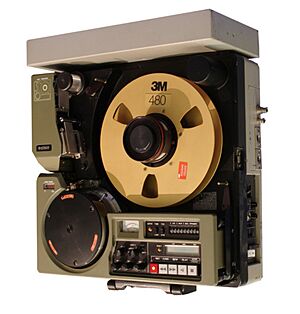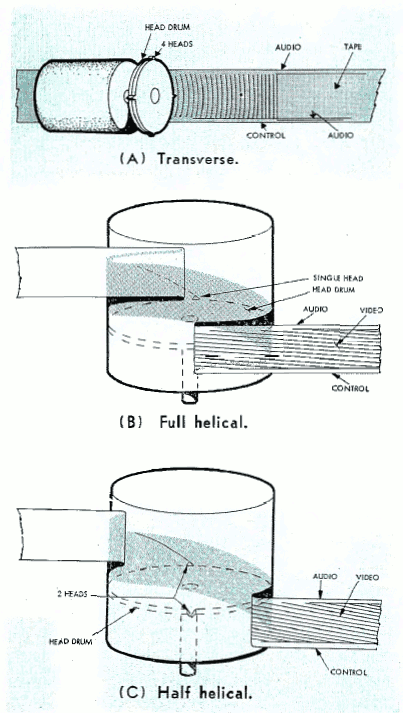Video tape recorder facts for kids
A video tape recorder (VTR) is a machine that can record and play back video and audio using magnetic tape. Early VTRs used large, open reels of tape, often 2 inches wide. These machines were first used in TV studios. They helped make recording TV shows cheaper and faster than using traditional motion picture film.
In 1963, VTRs made it possible to show instant replay during live sports events on TV. Later, around 1969, new types of VTRs came out where the tape was inside a videocassette. These machines became known as videocassette recorders, or VCRs.
Japanese companies agreed on a common way to record video, which meant tapes recorded on one company's machine could play on another's. This made it possible for VCRs to be sold to regular people. The first VCR for home use, which used the U-matic format, was released by Sony in 1971.
Contents
History of Video Recording
In 1951, famous singer Bing Crosby asked his engineer, John T. Mullin, if TV shows could be recorded on tape, just like audio. Mullin believed it was possible. Bing Crosby then asked Ampex to build a video recorder and also set up a lab for Mullin to work on one.
At first, people thought video signals needed tape to run very fast to record all the information. Video signals have much more information than audio signals. However, there was also a problem with the magnetic heads that read and write to the tape; they couldn't handle all the video information.
Early attempts to record video, using machines similar to audio recorders, didn't work well. The first demonstration in 1951 showed a very poor picture. Another early machine, developed by the BBC in 1952, used thin steel tape moving at over 200 inches per second! Even after 10 years, this machine wasn't widely used because it needed huge amounts of tape for just a few minutes of video.
By 1953, it was clear that the design of the magnetic heads was the main problem. Once this was fixed, more video information could be recorded. Since Bing Crosby's team and Ampex were working together, they shared this new head design. In 1955, Bing Crosby's company showed a color video recorder that worked well enough for TV broadcasts.
Many other recording systems were tried, but they all needed tape to move too fast. It became clear that a new way of recording was needed to handle the large amount of video information without using up tape too quickly.
In 1953, Eduard Schüller of Telefunken invented a method called helical scan. Another solution was developed by Ampex around 1954, called transverse-scan technology. In this method, the recording heads are on a spinning drum and record information across the tape. This allowed much more data to be stored on each inch of tape. It also meant the tape could move much slower, at 15 inches per second.
The Ampex VRX-1000 became the first successful video tape recorder sold to businesses in 1956. It used 2-inch wide tape. Because it cost about $50,000, only big TV networks and stations could afford it.
By early 1957, only one company, 3M, could make the high-quality tape needed for these machines. The three main U.S. TV networks officially started using videotape on April 28, 1957.
Ampex's system had some limits. For example, you couldn't pause the tape to see a clear still picture. Even with these drawbacks, it was the standard for TV studios until around 1980. The helical scan system later solved this problem.
In 1959, JVC showed its first helical scan VTR. In 1963, Philips released its EL3400 1-inch helical scan recorder for businesses and home users. Sony also released its 2-inch PV-100, an open-reel VTR for business, medical, and educational uses.
The Telcan, shown in June 1963, was the first home video recorder. It cost about £60 and could record for 20 minutes in black-and-white. However, it was expensive and not easy to put together.
The Sony model CV-2000, released in 1965, was their first VTR for home use, based on half-inch tape. Ampex and RCA also released their own open-reel black-and-white VTRs for under $1,000 in 1965. Pre-recorded videos for home use became available in 1967.
The EIAJ format was a standard half-inch format used by different companies. It was an open-reel format. Later, the EIAJ-2 used a cartridge that held one reel of tape, making it a bit easier to use.
Before VTRs, live TV was recorded onto film using a process called telerecording. Even after VTRs came out, this film process was still used for about ten years because early VTRs couldn't do things like freeze-frame.
How VTRs Work
In most VTRs, the recording heads are on a fast-spinning drum. This drum presses against the moving tape. The heads move across the tape in a diagonal path, recording the video signal in parallel tracks across the tape. This way, the VTR uses the full width of the tape, storing much more information per inch compared to audio recorders. The heads move very fast to record the video signal, but the tape itself moves much slower through the machine.
Also, three regular tracks are recorded along the edge of the tape by heads that don't move. One track is for the audio. Another is a control track with timing pulses, which helps the machine play back the video correctly. The third is a cueing track.
Early machines used the Ampex 2-inch system. In this system, the drum had 4 heads and spun very fast, recording tracks straight across the tape. For example, it took 16 tracks to record one video picture in the NTSC system.
The helical scan method uses a recording drum that spins at an angle. The tape wraps around this drum, so the tape heads move across the tape at a shallow angle. This records a long, diagonal track across the tape. This design allows a whole video picture to be recorded on just one track. This makes the electronics simpler. It also means you can pause the recorder during playback to see a single still picture. You just stop the tape, and the heads keep passing over the same track.
Videocassette Recorders (VCRs)
Many of the problems with open-reel systems were solved when the videocassette recorder (VCR) was invented. In a VCR, the videotape is inside a videocassette shell that is easy for people to use. This became the most common type of VTR for homes.
With cassettes, the tape is already attached to two reels inside the case. Loading and unloading the tape is automatic. Users don't need to touch the tape, which protects it from dust, dirt, and getting tangled. Usually, the only time someone touches the tape in a videocassette is if it gets stuck.
Home VCRs first became available in the early 1970s. Sony released its VO-1600 model in 1971, and Philips released its Model 1500 in England a year later. The first system that became very popular with regular people was Sony's Betamax (or Beta) in 1975.
Soon after, JVC released its competing VHS (Video Home System) format in 1977. Other formats like Video 2000 from Philips also appeared. The "Beta/VHS format war" then began. Other formats quickly disappeared, and Betamax sales slowly went down. After several years, VHS won the format war. In 1988, Sony even started selling its own VHS machines. Even though Sony said it still supported Beta, it was clear that Beta was no longer popular in most parts of the world. However, Betamax continued to be popular in some parts of South America and Japan until 2002.
Later, digital video tape formats replaced older analog tapes. After that, VCRs and videocassettes for home use were mostly replaced by other ways to store video, like DVDs and later Blu-ray discs.
Types of Video Recorders
Here are some of the different types of video tape recorder technologies that have been used:
- Older Open-Reel Systems
- 2-inch quadruplex (used by Ampex and RCA)
- 1-inch Type C (used by Sony, Ampex, and Hitachi)
- Professional Cassette Systems
- Betacam and Betacam SP (from Sony)
- MII (from Panasonic)
- U-matic (a 3/4-inch format)
- Digital Video Tape Formats
- Digital Betacam (from Sony)
- DVCAM (from Sony)
- DVCPRO (from Panasonic)
- HDCAM and HDCAM-SR (for high-definition video, from Sony)
- Home Consumer Formats
- Betamax
- VHS
- S-VHS (a better version of VHS)
- VHS-C (a smaller VHS cassette)
- Video8 and Hi8 (smaller formats)
- DV (and miniDV, a smaller cassette size)
- Digital8 (digital recording on 8mm tapes)
- Video 2000 (from Philips)
Cultural Impact
The famous song "Video Killed the Radio Star" by The Buggles, which was the first music video ever shown on MTV, includes the line "Put the blame on VTR."





